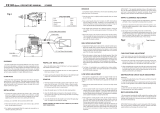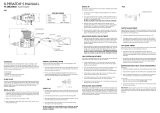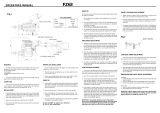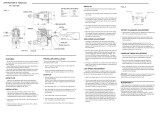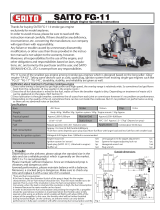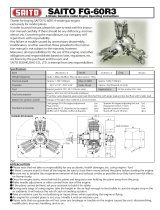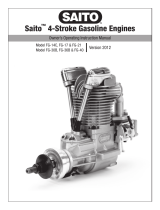Page is loading ...

SPECIFICATIONS
Bore 32mm
Stroke 29mm
Displacement 23cc
Weight 890g
Practical rpm 2,000-11,000rpm
FZ140-2 OPERATORS MANUAL
Fig.1
FEATURES
The FZ140 is a new generation engine that conforms for the
new F3A regulations. As in our 120 series, we equipped it wilth a
supercharge system assisted by the fuel tank pressurization
mechanism. The result is a powerful engine that is lighter in weight
than our 120 ‘s
Although the FZ140 has a bigger bore and stroke than our 120
Series, it will fit the same mounting bolt pattern.
GLOW PLUG
Select the most appropriate glow plug from those designed
specifically for 4 cycle engines. Glow plug selection greatly affects
the maximum engine output and low idle. lf RPM’s decrease or stop
when the booster cord is removed, replace the plug. We recomend
YS #4 or OS Type F.
INSTALLATION
1. Connect the engine to the tank as shown in fig.1. Since high
pressure is applied to the tank, tighten all connections carefully.
Care must be taken to prevent pressure leakage due to
undertightening of the check valve or by kinking the fuel lines.
2. Always use a fuel filter. We recommend theYS filter.
3. Match the direction of the check valve arrow to fig.1,with the
arrow facing towards the tank.
PROPELLER INSTALLATION
Due to the high torque of the FZ140 engine, we have equipped It
with double locknuts for safety.
1. Mount the propeller and tighten the rear nut. Next, tighten the
front nut as shown in Fig.1.
2. Select a good quality propeller that will turn in the 8,000 to 9,500
range, We recommend sizes 14x14,(15x12 through14)
(16x10 through 14).
START UP
1. Remove tube B from the filter; remove tube A from the check
valve, then fill the tank. (CAUTION, If tank is filled or
underpressure remove tube A first, then tube B. Fuel will eject if
tube B is removed while the tank is pressurized.)
2. Open the needle valve 2 1/2 from the fully closed position.
3. Open the throttle fully and slowly turn the propeller 10 times.
This primes the system by pressurizing the tank and sending
fuel to the carburetor.
4. Close the throttle to the idle position and connect the glow plug
cord. The engine is now ready for starting.
DO NOT ATTEMPT TO START AT FULL THROTTLE, AS THIS IS
VERY DANGEROUS.
BREAK-IN
To maximize engine performance and increase durability, please
follow this break- in procedure;
1. Use tho same size (or slightly smaller) propeller than you intend
to use in flying.
2. Use a good quality fuel which contains 15-30% nitromethane
and oil content of 20-24%. Synthetic or castor oil can be used, or
a combination of synthetic and castor. Do not use four cycle fuel
due to low oil content.
3. The needle valve should be set so that the engine is running at
rich setting. Run the engine approximately 20 minutes with this
setting.
4. Mount the engine to the model and fly ten times with this setting.
This concludes the break-in procedure, It is advisable to always
use a slightly rich setting to keep the moving parts lubricated,
even atter the break-in period .
HIGH SPEED ADJUSTMENT
1. Adjustment of high speed is done by the carburetor needle valve.
When the needle valve is turned clockwise, the mixture is leaner.
When it is turned counterclockwise, the mixture is richer. A good
starting position for the high speed needle valve is 2 1/2 turns
open from the fully closed position.
2. When the engine is started, open the throttle graduall. Next, find
the peak position (highest RPM) by adjusting the needle valve.
Then the needle valve should be opened approximately 1/8 of a
turn from full RPM to achieve best performance. The engine may
stop if the throttle is opened to full immediately atter starting.
Wait until the engine temperature rises and then open the throttle
slowly.
3. For flying, it is advisable to use a slightly richer mixture setting.
By using a richer mlxture, the engine temperature is maintained
and RPM stability improves.
LOW SPEED ADJUSTMENT
This engine is equipped with a new low speed needle valve to
adjust the mixture from low to mid throttle. This needle valve is
located on the side of the throttle barrel opposite the throttle arm
(Fig.1)
1. Open the low speed needle valve to 1 1/2 turns from fully closed
position.
2. The low speed needle valve should be set after the high speed
needle valve has been adjusted. Close the throttle gradually to
an idle (approximately 2500rpm). Let it idle for 20 to 30 seconds
and then slowly advance the throttle. The adjustment is satisfatory
at low speed if transition is smooth at this time.
3. If the engine is runnlng rough on idle, the low speed mixture is
rich. If the engine starts to speed up and dies on idle or starts to
detonate, when advancing the throttle, the mixture is lean. Turn
the low speed needle valve clockwise to richen and
counterclocwise for a leaner mixture (note that the direction of
the low speed needle valve is opposite the high speed needle
valve). Adjustments to the low speed needle valve should be 1/8
to 1/4 of a turn increment at a time to achieve smooth throttle
response.
IMPORTANT! The regulator adjusting screw on this engine is fatory
set. No further adjustments are necessary. If for some reason you
have to disassemble the regulator assembly, the regulator adjusing
screw should be set flush with the regulator body.
TAPPET CLEARANCE ADJUSTMENT
1. Tappet clearance is factory preset. No adjustment is necessary
until atter 1 hour of operation (including break-in period).
2. Clearance adjustment should be done when the engine is cool.
When the engine temperature is high, clearance is higher due to
thermal expansion.
3. The proper clearance setting should be at 0.04-0.Imm.
The adjustment is achieved by loosening the locknut (Fig. 2) and
turning the adjusting screw. Tighten the locknut atter the
adjusment is achieved. Atter the initial 1 hour adjustment, this
procedure should be performed atter every 2 hours of use.
Fig.2
CAM GEAR TIMING ADJUSTMENT
If for some reason you have to disassemble your engine, please
follow these important steps on reassembling the cam gear.
1. Remove the carburetor and backplate assembly. Notice the
impression made on the crankshatt counterweight. Position it
directly straight down or in line with the case outer seam line.
2. When reinstalling the cam gear, the side with a point mark should
be facing the opening of the gear box, Note that it should also be
mounted with the point mark located towards the top of the
engine just below the cam followers.
DIAPHRAGM AND CHECK VALVE DISASSEMBLY
Diaphragm:
1. Remove the adjustment screw of the valve, and then remove the
inside valve and spring.
2. Clean the inside with alcohol or appropriate cleaner.Reassemble.
3. Screw in the regulator screw until flush with the diaphragm body.
Check valve;
1. Open the valve by rotating the body counterclockwise.
2. Reassemble the check valve carefully.
IMPORTANT! Silicone rubber is used in many parts of the YSengine.
Use only glow fuel or methanol for cleaning. Gasoline and other
volatile solutions will damage the silicone if used.
Tube A
High Speed Needle
Low Speed Needle Check Valve
YS Fuel Filters
(YS1195/not included)
Tube B
112.5
2563
128
58
Tappet Clearance

1 F1701 Crankcase 1
F1202S Valve Cover Assembly
2 F1202 Valve Cover 1
3 F1203 Head Cover Gasket 1
4 F1204 Valve Cover Screw Set 2
5 F1505 Head Gasket 1
F1506A Head Assembly
6 F1506 Cylinder Head 1
7 F1407 Intake Valve 1
8 F1408 Exhaust Valve 1
9 F1409 Valve Spring Set 2
10 F1410 Spring Retainer Set 2
11 F1411 Valve Spring Retainer Clips 4
12 F1212 Rocker Arm Set
13 F1213 Tappet Adjusting Screw Set 2
14 F1214 Tappet Adjusting Rock Nuts 2
15 F1215 Rocker Arm Shaft 1
16 F1216 Rocker Arm Shaft Screw 1
17 F1217 E Ring Set 2
18 F1518 Head Bolt Set 5
19 F1519 Crankshaft 1
20 F1520 Cylinder Liner 1
21 F1521 Piston 1
22 F1222 Wrist Piston 1
23 F1523 Wrist Pin Retainer Set 2
24 F1524 Piston Ring 1
25 F1525 Connecting Rod 1
F1716A Back Plate Assembly
26 F1726 Back Plate 1
27 F1427 Disc Valve 1
28 F1428 Rear Disc Valve Retainer 1
29 F1429 Retainer Screw 1
30 F1230 Back Plate Gasket 1
31 F1539 Back Plate Screw Set 6
32 F1232 Cam Gear Cover 1
33 F1233 Cam Gear Cover O-Ring 1
34 F1534 Cam Gear Cover Screw Set 2
35 F1535 Cam Gear 1
36 F1236 Cam Followers Set 2
37 F1537 Push Rod Set 2
38 F1538 Push Rod Cover Set 2
39 F1239 Push Rod Cover O-Ring 4
40 F1240 Front Bearing 1
41 F9122 Front Bearing Oil Seal 1
42 F1341 Rear Bearing 1
43 F1242 Cam Gear Bearing Set 2
44 F1534 Fuel Nipples Set With Washers 6
F1244A Regulator Assembly
45 F1244 Regulator Body 1
46 F1245 Regulator Adjusting Screw 1
47 F1246 Regulator Adjusting Screw O-Ring 1
48 F1247 Diaphram 1
49 F1248 Regulator Plunger 1
50 F1249 Plunger Spring 1
51 F1250 Regulator Gasket 1
52 F1251 Regulator Screw Set 2
53 F1496 Regulator Ballast 1
F1752A Carburetor Assembly
54 F1752 Carburetor Body 1
55 F1753 Throttle Barrel 1
56 F9156 Low Speed Needle Valve 1
57 F9157 Low Speed Needle Valve O-Ring 1
F1545S Needle Valve Assembly
58 F1545 High Speed Needle Valve 1
59 F1546 High Speed Needle Valve O-ring 1
60 F1555 High Speed Needle Valve Seat 1
61 F1256 Needle Valve Socket O-Ring Set 3
62 F1557 Needle Valve Detent 1
63 F1483 Throttle Barrel Seal 1
64 R6124 Throttle Barrel Retainer 1
65 F1258 Throttle Stop Screw 1
66 F1259 Throttle Stop Spring 1
67 F1260S Throttle Arm Set 1
68 F1463 Carburetor Gasket 1
69 F1564 Drive Washer 1
70 F1565 Drive Washer Retainer 1
71 F1568 Intake Pipe 1
72 F1269 Intake Pipe O-Ring 4
73 F1382 Wrist Pin Access Plug 1
74 F1266 Propeller Washer 1
75 F1267 Propeller Nut Set 2
F1473S Gasket Set 4
F1574S O-Ring Set 13
#
PART
#
DESCRIPTION
QTY
'00 J 20
YAMADA MFG.CO.,LTD
67 Tsuchitori Inuyama Aichi 484-0917 JAPAN TEL: 0568 67 0265 FAX: 0568 67 7801
WARRANTY
Strict quality control is implemented by our factory in all phases, from parts manufactiring
to final assembly. If performavce deteriorates or a part fails due to a manufacturing error,YS
will repair or replace the engine at no charge. Warranty will not cover normal wear.
Should the engine be modified, incorrectly assembled or abused, there will be a normal
charge for parts and labor. The use of four cycle fuel due to low oil content will also void
warrany.
/
